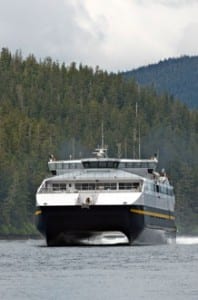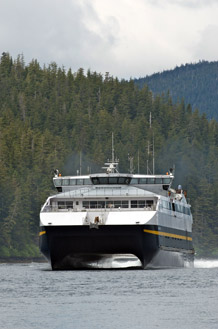Planners with the Alaska Department of Transportation fielded questions from a packed house of skeptical residents from Petersburg and Kupreanof last week. The DOT officials were vetting a draft of the state’s latest plan for transportation for Southeast. Local residents were concerned with a loss of ferry service. They also faulted the plan’s focus on construction of new roads while existing pavement goes unmaintained.
The document helps outline priorities for the state Department of Transportation over the next decade. The most recent Southeast Alaska Transportation Plan came out ten years ago. DOT highway planner Marie Heidemann explained the need for the plan update. “You know the purpose of the plan is partly because we need to meet requirements. We need to meet federal requirements, we also need to fulfill the requirement for an Alaska Marine Highway System long-range plan. But more important than that we need to every so often we need to revisit every so often what are the current trends that are happening in the region. What are the current projects and priorities of the state? We need to look at that, look at the trends and use those to guide how we want to the transportation system to look.”
One of the trends the DOT has identified is an excess of capacity on the state’s ferry system. Southeast region planning chief Andy Hughes said ridership has not risen despite relatively stable fares. “We’ve added vessels, we’ve added frequency of service and we’re moving less people. In spite of the fact that, when you consider that we haven’t really raised our fares much over the period. And when you keep fares nearly level that in effect means you’re actually reducing fares relative to people’s income.”

Hughes said the Marine Highway could retire a ferry and still have enough capacity for the current demand. The plan recommends doing just that with the older mainline ships. Those are the vessels connecting Southeast Alaska communities to Bellingham, Washington or Prince Rupert, British Columbia. It recommends replacing or retiring the Malaspina, Matanuska and Taku by the year 2024. Two planned Alaska Class ferries would take up service in Lynn Canal and one new mainline ferry could be built for an estimated 226 million dollars.
Dave Kensinger thought the plan would leave Petersburg with less ferry service. “From a person that has actually used the ferry system extensively for 37 years from the time when some of these vessels were nearly new, I can tell you that if you get rid of the Mal, the Mat and the Taku and at some point in the future you plan on building another mainliner, we’re going to be without transportation here. All you need to do is pick up a ferry schedule and see what provides our transportation.”
Kensinger said ferry stops in Petersburg used to be more frequent and more convenient for other communities to visit here. “People from Kake could ride the ferry LeConte into town here, they had a two tide layover. They came here, they shopped, they left the boat in port for eight hours and they went back to Kake. They did that for darn near 20 years. So, I mean we had a transportation system that worked for the communities in central Southeast Alaska for many decades. And guess what, we had the same vessels then as we do now, plus a few more. So everybody out here is kinda asking the question, guys, why can’t I get anywhere on the ferry now?”
Other commenters focused on scheduling of the state ferries and thought the state’s estimates for demand were not accurate. Stephen Samuelson thought the system’s ridership numbers are faulty because of poor scheduling and redundant service. “And the reason being is because the I’ve watched the Malaspina run up Lynn Canal or even come through here and then an hour later you watch the Matanuska go right behind it.” Samuelson explained that people crowd onto the first ferry through and the second boat just behind remains empty.
Cindi Lagoudakis wanted to make sure the plan’s anticipated costs for school travel would be addressed. “Our students travel on the ferry frequently to academic and to sports activities and some of what you are proposing will end up precluding that participation and some of it will end up costing the school much more money to have teachers and students traveling for more extended periods of time.”
Much of the focus at the meeting in Petersburg was on a road project included in the plan. The state has appropriated 40 million dollars for a road across Kupreanof Island. If that one lane road is built along with a shuttle ferry across the Wrangell Narrows it would allow motorists to drive between Kake and Petersburg.
Hughes fielded questions about that road. “This plan simply is proposing to construct a local road for local use to the advantage of residents of both communities, primarily Kake to provide them with access to the services, all of the services and resources medical, commercial and transportation resources available to Petersburg, which are considerable compared to what Kake has available,” he said.
Hughes said planners would be surveying residents of Kake and Petersburg to find out why they travel outside of the two communities. That information will become part of the environmental review for the Kake road project, which is being jointly compiled by the Federal Highway Administration and state DOT. A draft environmental document could be out in 2016.
Local residents questioned Hughes about the level of maintenance and snow removal of the proposed road, and costs for law enforcement. Others wondered why the road money could not be spent on a power connection to bring cheap hydro electricity to Kake.
“It seems like that poor community has been held captive for power since I moved to Southeast Alaska 25 years ago,” said Nicole McMurren. “And there seems to be an assumption by the state that roads good – ferry bad.”
The draft plan recommends a major road project out of the Capital City to shorten the ferry route times in Lynn Canal. It also recommends a road and tunnel from Sitka across Baranof Island to a proposed ferry terminal at Warm Springs Bay. That option would allow the state to end direct ferry service to downtown Sitka.
The DOT planners also heard about the poor condition of existing state owned roads in Petersburg. Several are slated for pavement replacement in the next year but that work has been delayed.
Jill Williams praised the DOT maintenance crew in Petersburg but thought they needed more funding to patch roads and put in new crosswalks. “If they got the go ahead from Juneau they could put in cross walks, it doesn’t take that long. The city does it for us when we need it for safety. And it’s a safety issue for our town. So it’s maintenance. We shouldn’t have to wait for the road to be totally done for the big project. It’s called maintenance, yearly maintenance.”
Other meetings on the draft Southeast plan are scheduled this month in Ketchikan, Sitka and Kake along with meetings in Skagway and Haines early next month.
The document can be viewed on the Department of Transportations southeast region website. Comments are due in by September 30.












